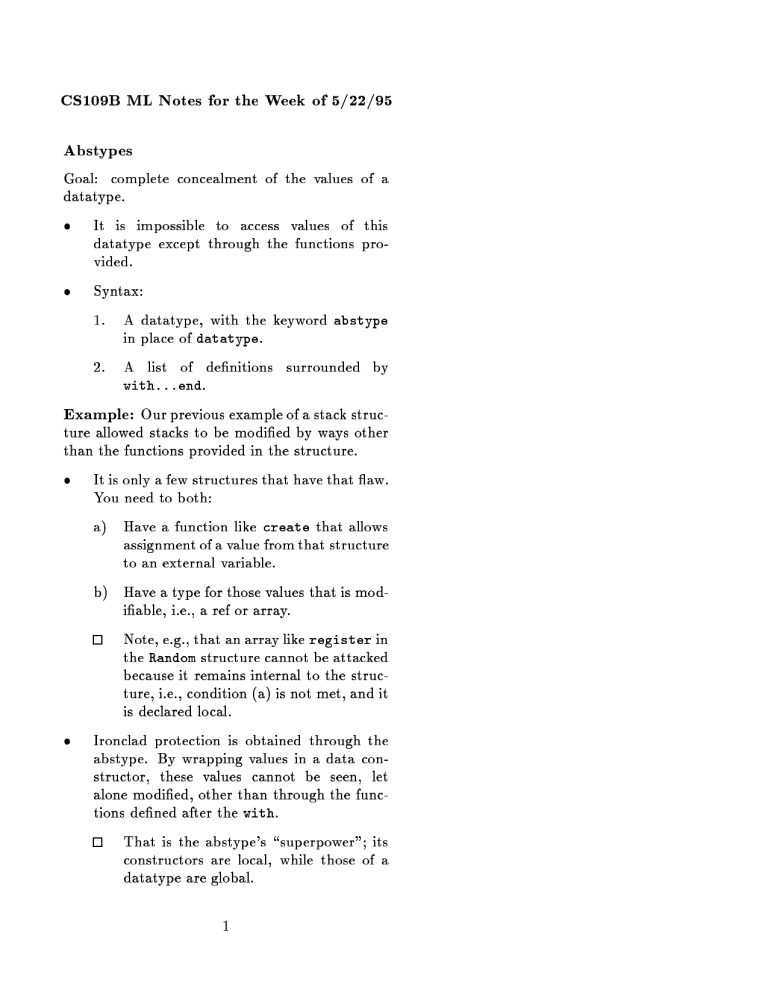
CS109B ML Notes for the Week of 5/22/95 Abstypes Goal: complete concealment of the values of a datatype. It is impossible to access values of this datatype except through the functions provided. Syntax: 1. A datatype, with the keyword abstype in place of datatype. 2. A list of de nitions surrounded by with...end. Example: Our previous example of a stack structure allowed stacks to be modi ed by ways other than the functions provided in the structure. It is only a few structures that have that aw. You need to both: a) Have a function like create that allows assignment of a value from that structure to an external variable. b) Have a type for those values that is modi able, i.e., a ref or array. Note, e.g., that an array like register in the Random structure cannot be attacked because it remains internal to the structure, i.e., condition (a) is not met, and it is declared local. Ironclad protection is obtained through the abstype. By wrapping values in a data constructor, these values cannot be seen, let alone modi ed, other than through the functions de ned after the with. That is the abstype's \superpower"; its constructors are local, while those of a datatype are global. 1 Example: Here is the stack example with values wrapped in data constructor Stk. abstype '1a stack = Stk of '1a list ref with exception EmptyStack; fun create(x:'1a) = Stk(ref [x]); fun push(x,Stk(s)) = s := x:: !s; fun top(Stk(ref nil)) = raise EmptyStack | top(Stk(ref(x::xs))) = x; fun pop(Stk(ref nil)) = raise EmptyStack | pop(Stk(s)) = s := tl(!s); end; Note that funny type variable '1a. It is needed because we de ne a stack to be a reference to a list of elements of this type, and references cannot be to arbitrary types. The type must involve only concrete subtypes, e.g., int*int or int->int, but not 'a or 'a->'a. We can do the usual push, pop, etc., as if the Stk weren't there. But an attempt to get at the value of a stack directly is doomed to failure: fun grab(Stk(x)) = tl(!x); Error: non-constructor applied to argument in pattern: Stk Functors (Simple Form) Consider the structure Random from the previous notes. It had built into it a particular size of the register array and a particular \feedback function," the positions of the array that got complemented. We might like to generate a number of similar structures with di erent sizes and feedback functions. The functor is the ML construct that lets us do so. It consists of, in its simplest form: 2 1. The keyword functor followed by the name of the functor. 2. A parenthesized argument structure and its signature. 3. An equal sign and the de nition of the structure created by the functor from the argument structure. Example: Here is a signature suitable for the argument of a functor MakeRandom. This signature describes an integer n (the size of the register) and a list feed of the positions in the register that get complemented. signature RANDOM DATA = sig val n : int; val feed : int list; end; The functor MakeRandom is in Fig. 1. Notice how the output structure of the functor must open the input structure (the line open Data) in order to get the needed components n and feed. Applying a Functor Now, we can de ne a structure with the correct signature to provide the needed parameters, n and feed. Here is an example: structure MyData: RANDOM DATA = struct val n = 20; val feed = [0,2,4,6,7,14,17,19]; end; Finally, we apply functor MakeRandom to the structure MyData. The result is another structure, Random, that behaves like the old Random, but with the new size n and new feedback function. structure Random = MakeRandom(MyData); This structure Random is used exactly like the one from the previous notes. 3 functor MakeRandom(Data: RANDOM DATA): sig open Data; val init: unit -> unit; val getBit: unit -> int; end = struct open Data; val register = array(n,0); fun feedback1(nil) = () | feedback1(x::xs) = ( update(register,x,1-sub(register,x)); feedback1(xs)); fun feedback() = feedback1(feed); fun shift1(0) = update(register,0,0) | shift1(i) = ( update(register,i,sub(register,i-1)); shift1(i-1)); fun shift() = shift1(n-1); fun init1(0) = ( update(register,n-1,1); update(register,0,0)) | init1(i) = ( update(register,i,0); init1(i-1)) fun init() = init1(n-1); fun getBit() = let val bit = sub(register,n-1); in ( shift(); if bit=1 then feedback() else (); bit) end; end; Fig. 1. Functor MakeRandom. 4

